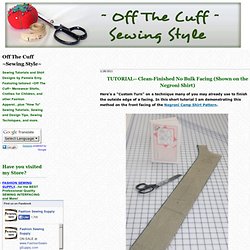

! Interfacing Tips & Tricks. Fused Interfacing: Tailor's Tricks. Block Fusing is a method that many modern tailors and home-sewists use to apply interfacing to fashion fabric yardage before the pattern pieces are cut out.

Have you ever struggled keeping the interfacing layer from slipping off-grain as you attempt to fuse it to your fabric yardage? Next time, try this fast, easy, and accurate method that I learned from a Master Tailor, called "SPOT-FUSING"...And it can be done right on your cutting table! First, we need to prepare the surface of the table. The photo above shows my cutting table covered with 2 layers of HEAVY weight muslin (from Gorgeous Fabrics), and one layer of very thick wool (a heavy wool blanket will work as well..I just happen to have felted wool yardage that I use for this technique).
It is VERY important that these layers be smooth and free of wrinkles, so thoroughly smooth them out before proceeding. Next, lay out your fashion fabric on top of your "padded" table, WRONG side UP...making SURE it is smooth. Understanding Lining Fabric + Resources. This is a follow-up post to this post and again, if you don’t have Easy Guide to Sewing Linings by Connie Long, you need it and you should buy the e-book right now! Today, I wanted to share my online resources plus a few tips on what kinds of fabrics can work as a lining.
Sometimes ideas from others make a big difference in how we view the usefulness of a fabric. So here goes. bemberg rayon lining First let’s talk lining fabrics and what kinds of fabrics work as linings that aren’t labeled “linings.” Silk charmeuse solid & printed Let me acquaint you with my favorite luxury lining – silk charmeuse. Silk crepe de chine, printed & solid. Bag Your Jacket Lining. Lining a jacket makes it last longer and become easier to slip on and off.

Best yet, using the bagging method is as quick or quicker than finishing an unlined jacket. Photo: Sloan Howard. by Sandra Millettfrom Threads #88, pp. 56-59 Sewing jackets is something I like to do, but lining them is another matter. By the time I get to that point in construction, I'm ready to put on my new jacket and sashay out the door. Prepare to bag All jackets benefit from having a lining; it lets the jacket slide easily over other clothes, drape correctly on the body, and stand up to wear and tear. If you're using a pattern without a lining, it's easy to make a lining pattern. The bagging procedure begins only after the jacket and lining have been constructed, but there are a few details to attend to before construction. Since the jacket's seam allowances will be pressed open, don't serge any two seam allowances together, as you might be tempted to do, for example, on the center-back seam.